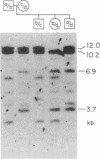Abstract
Restriction endonuclease digestion of genomic DNA from 24 lymphoblastoid cell lines homozygous for the HLA class II specificity DQw3, followed by hybridization with a DQ beta-chain cDNA probe, identified a genomic polymorphism with variable BamHI and HindIII recognition sites. This restriction fragment pattern was found for several haplotypes associated with the DQw3 specificity, including some haplotypes positive for the HLA-DR specificities DR4, DR5, DRw8, and DRw12. The variant fragment pattern corresponds precisely with the reactivity of a monoclonal antibody, A-10-83, previously shown to define a serologic split of DQw3. Serologic detection of the specific DQw3.1 genomic polymorphism indicated that the corresponding DQ beta-chain variants are expressed. This polymorphic restriction fragment pattern, then, represents a selective marker for DQ beta-chain genes that appear to define a DQ beta-chain-associated specificity, here called DQw3.1.
Full text
PDF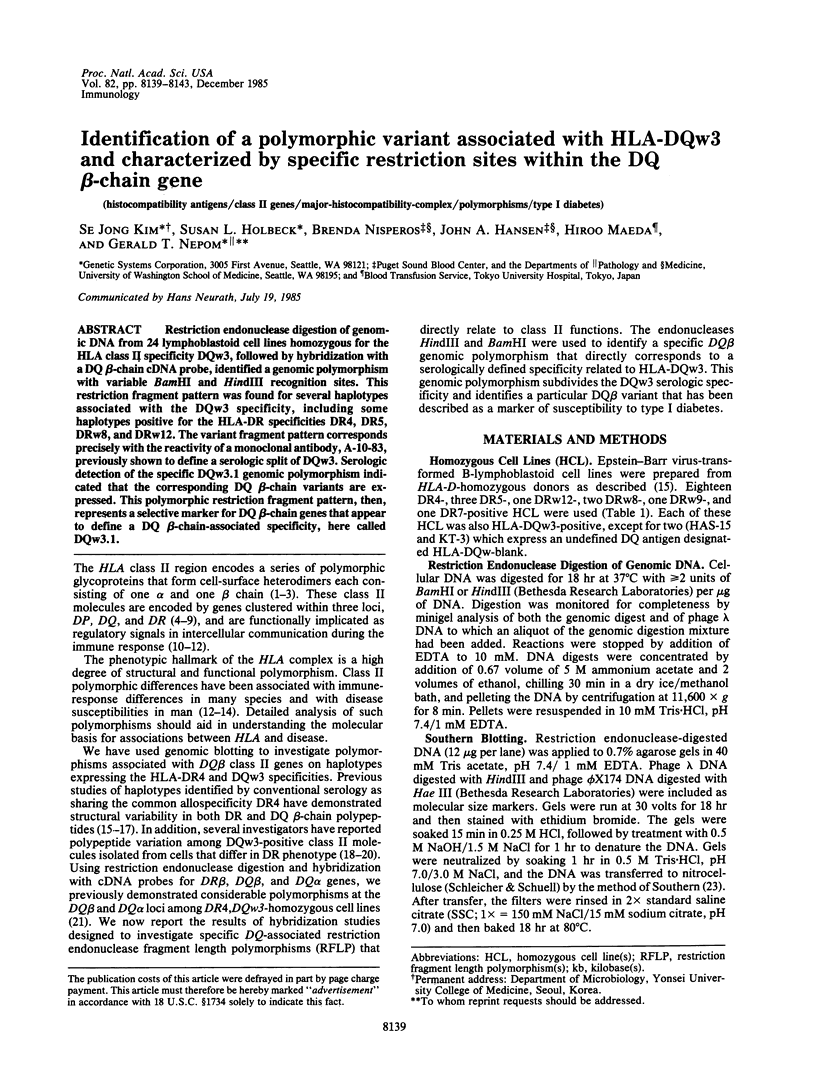
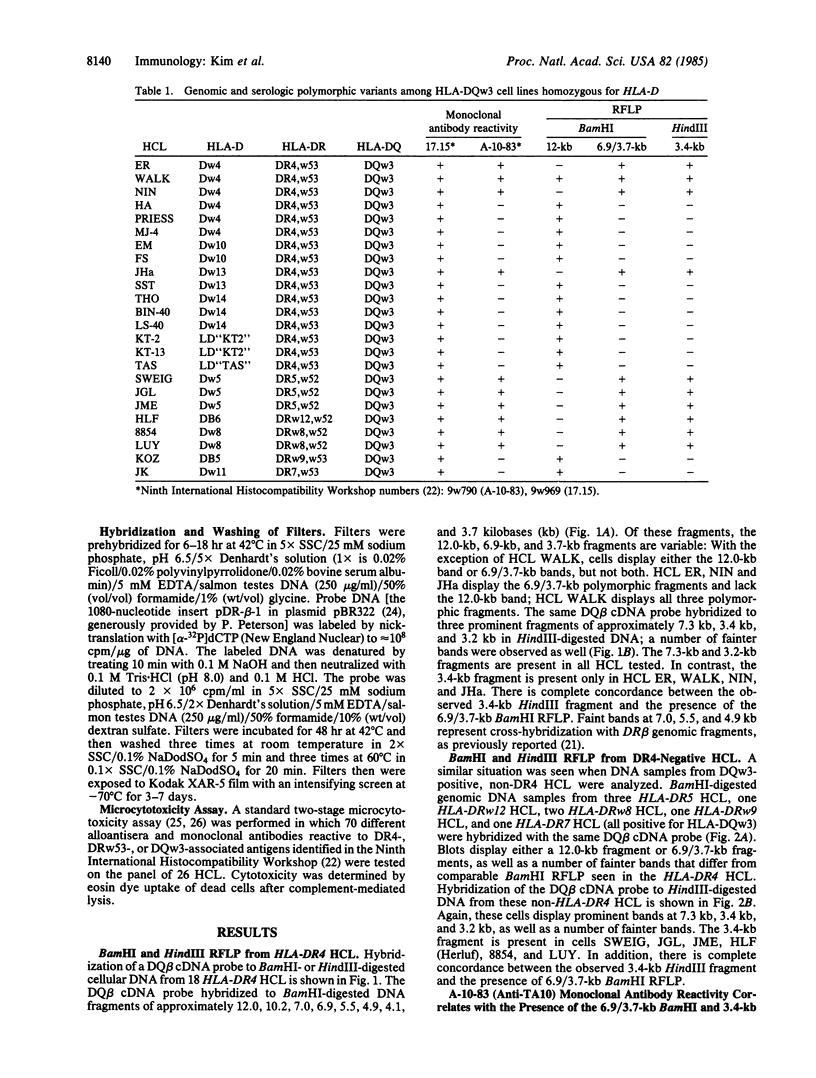
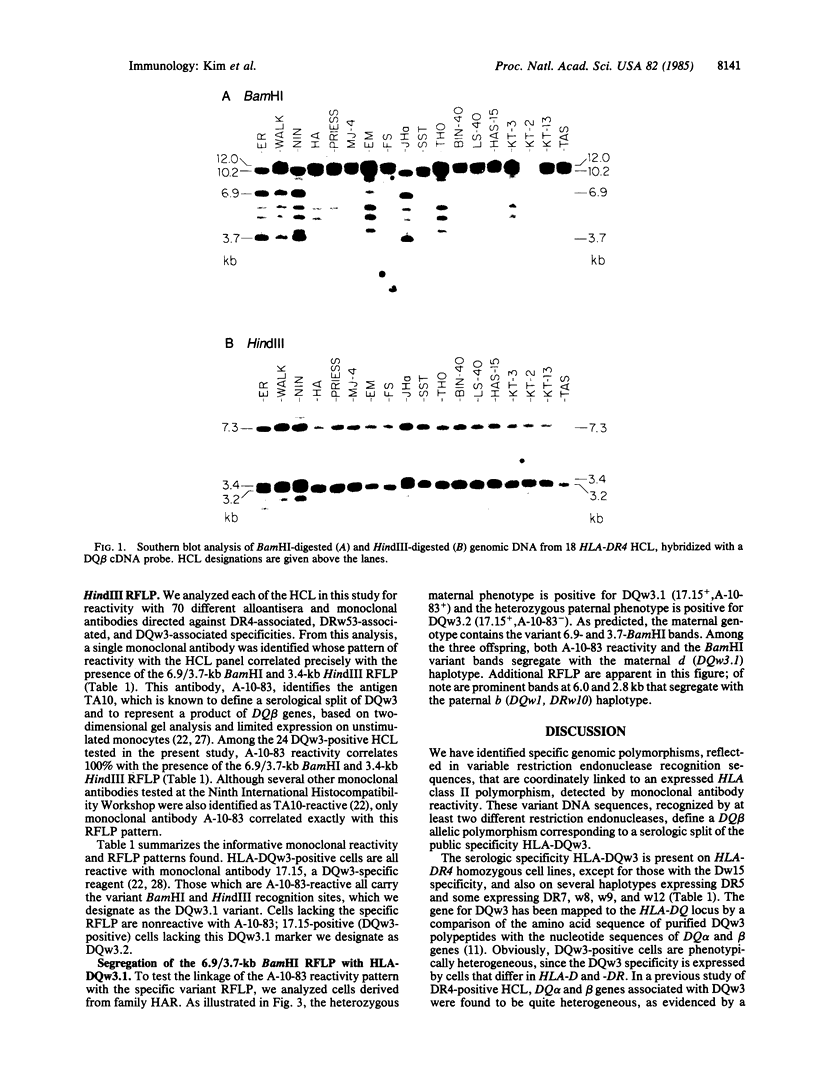
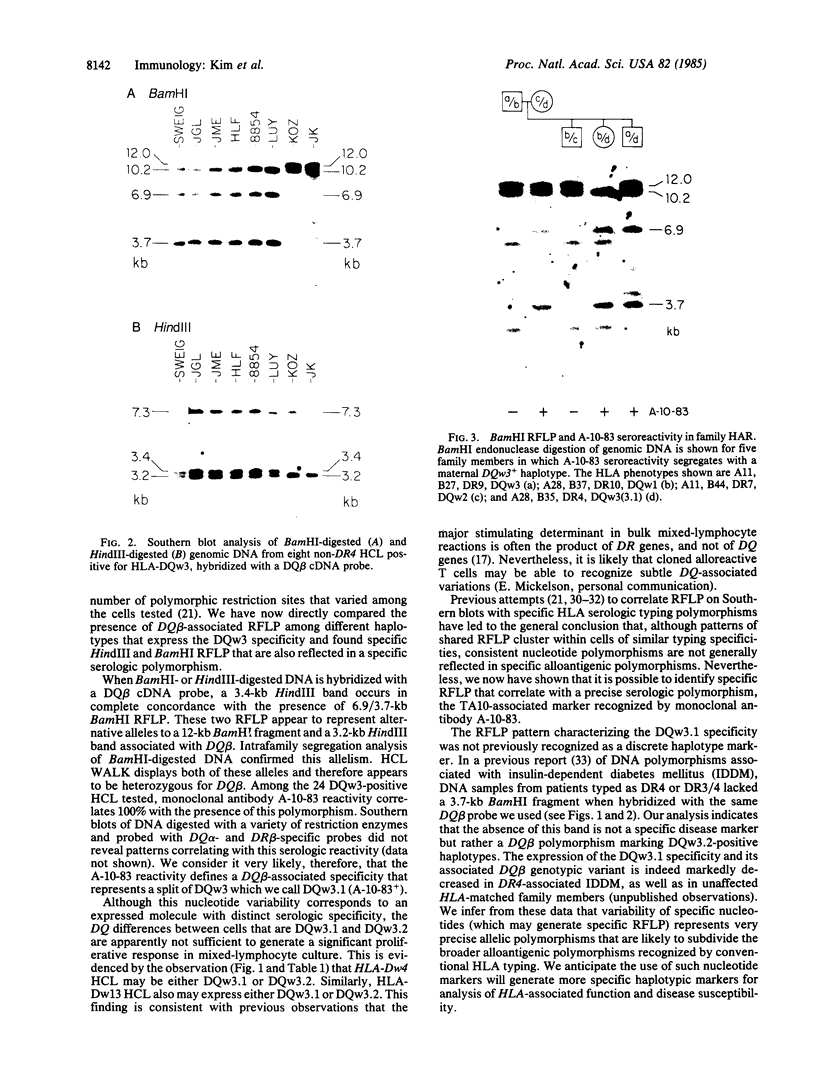
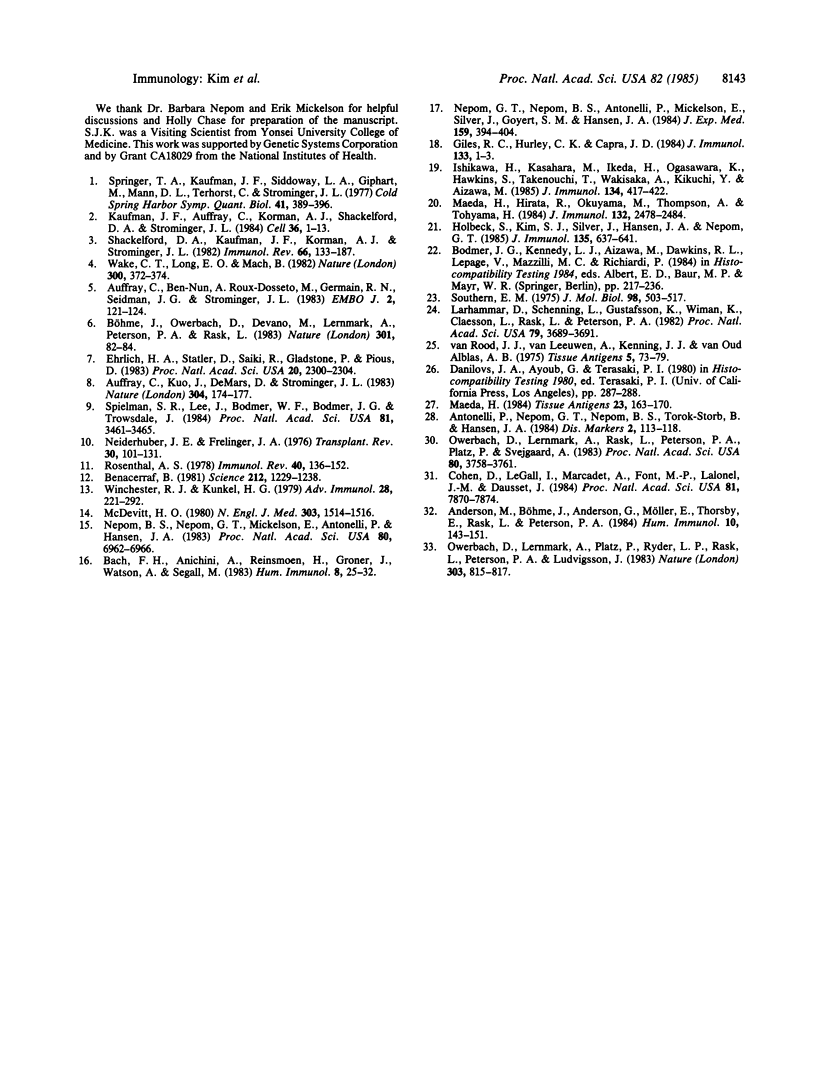
Images in this article
Selected References
These references are in PubMed. This may not be the complete list of references from this article.
- Auffray C., Ben-Nun A., Roux-Dosseto M., Germain R. N., Seidman J. G., Strominger J. L. Polymorphism and complexity of the human DC and murine I-A alpha chain genes. EMBO J. 1983;2(1):121–124. doi: 10.1002/j.1460-2075.1983.tb01392.x. [DOI] [PMC free article] [PubMed] [Google Scholar]
- Auffray C., Kuo J., DeMars R., Strominger J. L. A minimum of four human class II alpha-chain genes are encoded in the HLA region of chromosome 6. Nature. 1983 Jul 14;304(5922):174–177. doi: 10.1038/304174a0. [DOI] [PubMed] [Google Scholar]
- Bach F. H., Anichini A., Reinsmoen N., Groner J., Watson A., Segall M. Genetic and molecular analyses of lymphocyte-defined HLA-D region specificities. Hum Immunol. 1983 Sep;8(1):25–32. doi: 10.1016/0198-8859(83)90078-2. [DOI] [PubMed] [Google Scholar]
- Benacerraf B. Role of MHC gene products in immune regulation. Science. 1981 Jun 12;212(4500):1229–1238. doi: 10.1126/science.6165083. [DOI] [PubMed] [Google Scholar]
- Böhme J., Owerbach D., Denaro M., Lernmark A., Peterson P. A., Rask L. Human class II major histocompatibility antigen beta-chains are derived from at least three loci. Nature. 1983 Jan 6;301(5895):82–84. doi: 10.1038/301082a0. [DOI] [PubMed] [Google Scholar]
- Cohen D., Le Gall I., Marcadet A., Font M. P., Lalouel J. M., Dausset J. Clusters of HLA class II beta restriction fragments describe allelic series. Proc Natl Acad Sci U S A. 1984 Dec;81(24):7870–7874. doi: 10.1073/pnas.81.24.7870. [DOI] [PMC free article] [PubMed] [Google Scholar]
- Erlich H. A., Stetler D., Saiki R., Gladstone P., Pious D. Mapping of the genes encoding the HLA-DR alpha chain and the HLA-related antigens to a chromosome 6 deletion by using genomic blotting. Proc Natl Acad Sci U S A. 1983 Apr;80(8):2300–2304. doi: 10.1073/pnas.80.8.2300. [DOI] [PMC free article] [PubMed] [Google Scholar]
- Giles R. C., Hurley C. K., Capra J. D. Primary structural variation among serologically indistinguishable DS antigens: the MB3-bearing molecule in DR4 cells differs from the MB3-bearing molecule in DR5 cells. J Immunol. 1984 Jul;133(1):1–3. [PubMed] [Google Scholar]
- Holbeck S. L., Kim S. J., Silver J., Hansen J. A., Nepom G. T. HLA-DR4-associated haplotypes are genotypically diverse within HLA. J Immunol. 1985 Jul;135(1):637–641. [PubMed] [Google Scholar]
- Ishikawa N., Kasahara M., Ikeda H., Ogasawara K., Hawkin S., Takenouchi T., Wakisaka A., Kikuchi Y., Aizawa M. Demonstration of structural polymorphism among MB3 light chains by two-dimensional gel electrophoresis. J Immunol. 1985 Jan;134(1):417–422. [PubMed] [Google Scholar]
- Kaufman J. F., Auffray C., Korman A. J., Shackelford D. A., Strominger J. The class II molecules of the human and murine major histocompatibility complex. Cell. 1984 Jan;36(1):1–13. doi: 10.1016/0092-8674(84)90068-0. [DOI] [PubMed] [Google Scholar]
- Larhammar D., Schenning L., Gustafsson K., Wiman K., Claesson L., Rask L., Peterson P. A. Complete amino acid sequence of an HLA-DR antigen-like beta chain as predicted from the nucleotide sequence: similarities with immunoglobulins and HLA-A, -B, and -C antigens. Proc Natl Acad Sci U S A. 1982 Jun;79(12):3687–3691. doi: 10.1073/pnas.79.12.3687. [DOI] [PMC free article] [PubMed] [Google Scholar]
- Maeda H., Hirata R., Okuyama M., Thompson A., Tohyama H. Two-dimensional gel analysis of a second family of class II molecules by polymorphic HLA-DR4,5, and w9 monoclonal antibodies. J Immunol. 1984 May;132(5):2478–2484. [PubMed] [Google Scholar]
- Maeda H. Mouse monoclonal antibody detects a new polymorphic Ia determinant other than HLA-DR antigen: a possible allele of DC-1. Tissue Antigens. 1984 Mar;23(3):163–170. doi: 10.1111/j.1399-0039.1984.tb00027.x. [DOI] [PubMed] [Google Scholar]
- McDevitt H. O. Regulation of the immune response by the major histocompatibility system. N Engl J Med. 1980 Dec 25;303(26):1514–1517. doi: 10.1056/NEJM198012253032606. [DOI] [PubMed] [Google Scholar]
- Nepom B. S., Nepom G. T., Mickelson E., Antonelli P., Hansen J. A. Electrophoretic analysis of human HLA-DR antigens from HLA-DR4 homozygous cell lines: correlation between beta-chain diversity and HLA-D. Proc Natl Acad Sci U S A. 1983 Nov;80(22):6962–6966. doi: 10.1073/pnas.80.22.6962. [DOI] [PMC free article] [PubMed] [Google Scholar]
- Nepom G. T., Nepom B. S., Antonelli P., Mickelson E., Silver J., Goyert S. M., Hansen J. A. The HLA-DR4 family of haplotypes consists of series of distinct DR and DS molecules. J Exp Med. 1984 Feb 1;159(2):394–404. doi: 10.1084/jem.159.2.394. [DOI] [PMC free article] [PubMed] [Google Scholar]
- Nepom G. T., Nepom B. S., Wilson M. E., Mickelson E., Antonelli P., Hansen J. A. Multiple Ia-like molecules characterize HLA-DR2-associated haplotypes which differ in HLA-D. Hum Immunol. 1984 Jul;10(3):143–151. doi: 10.1016/0198-8859(84)90035-1. [DOI] [PubMed] [Google Scholar]
- Niederhuber J. E., Frelinger J. A. Expression of Ia antigens on T and B cells and their relationship to immune-response functions. Transplant Rev. 1976;30:101–121. [PubMed] [Google Scholar]
- Owerbach D., Lernmark A., Platz P., Ryder L. P., Rask L., Peterson P. A., Ludvigsson J. HLA-D region beta-chain DNA endonuclease fragments differ between HLA-DR identical healthy and insulin-dependent diabetic individuals. Nature. 1983 Jun 30;303(5920):815–817. doi: 10.1038/303815a0. [DOI] [PubMed] [Google Scholar]
- Owerbach D., Lernmark A., Rask L., Peterson P. A., Platz P., Svejgaard A. Detection of HLA-D/DR-related DNA polymorphism in HLA-D homozygous typing cells. Proc Natl Acad Sci U S A. 1983 Jun;80(12):3758–3761. doi: 10.1073/pnas.80.12.3758. [DOI] [PMC free article] [PubMed] [Google Scholar]
- Rosenthal A. S. Determinant selection and macrophage function in genetic control of the immune response. Immunol Rev. 1978;40:136–152. doi: 10.1111/j.1600-065x.1978.tb00404.x. [DOI] [PubMed] [Google Scholar]
- Shackelford D. A., Kaufman J. F., Korman A. J., Strominger J. L. HLA-DR antigens: structure, separation of subpopulations, gene cloning and function. Immunol Rev. 1982;66:133–187. doi: 10.1111/j.1600-065x.1982.tb00437.x. [DOI] [PubMed] [Google Scholar]
- Southern E. M. Detection of specific sequences among DNA fragments separated by gel electrophoresis. J Mol Biol. 1975 Nov 5;98(3):503–517. doi: 10.1016/s0022-2836(75)80083-0. [DOI] [PubMed] [Google Scholar]
- Spielman R. S., Lee J., Bodmer W. F., Bodmer J. G., Trowsdale J. Six HLA-D region alpha-chain genes on human chromosome 6: polymorphisms and associations of DC alpha-related sequences with DR types. Proc Natl Acad Sci U S A. 1984 Jun;81(11):3461–3465. doi: 10.1073/pnas.81.11.3461. [DOI] [PMC free article] [PubMed] [Google Scholar]
- Springer T. A., Kaufman J. F., Siddoway L. A., Giphart M., Mann D. L., Terhorst C., Strominger J. L. Chemical and immunological characterization of HL-A linked B-lymphocyte alloantigens. Cold Spring Harb Symp Quant Biol. 1977;41(Pt 1):387–396. doi: 10.1101/sqb.1977.041.01.046. [DOI] [PubMed] [Google Scholar]
- Wake C. T., Long E. O., Mach B. Allelic polymorphism and complexity of the genes for HLA-DR beta-chains--direct analysis by DNA-DNA hybridization. Nature. 1982 Nov 25;300(5890):372–374. doi: 10.1038/300372a0. [DOI] [PubMed] [Google Scholar]
- Winchester R. J., Kunkel H. G. The human Ia system. Adv Immunol. 1979;28:221–292. [PubMed] [Google Scholar]
- van Rood J. J., van Leeuwen A., Keuning J. J., van Oud Alblas A. B. The serological recognition of the human MLC determinants using a modified cytotoxicity technique. Tissue Antigens. 1975 Apr;5(2):73–79. doi: 10.1111/j.1399-0039.1975.tb00532.x. [DOI] [PubMed] [Google Scholar]






